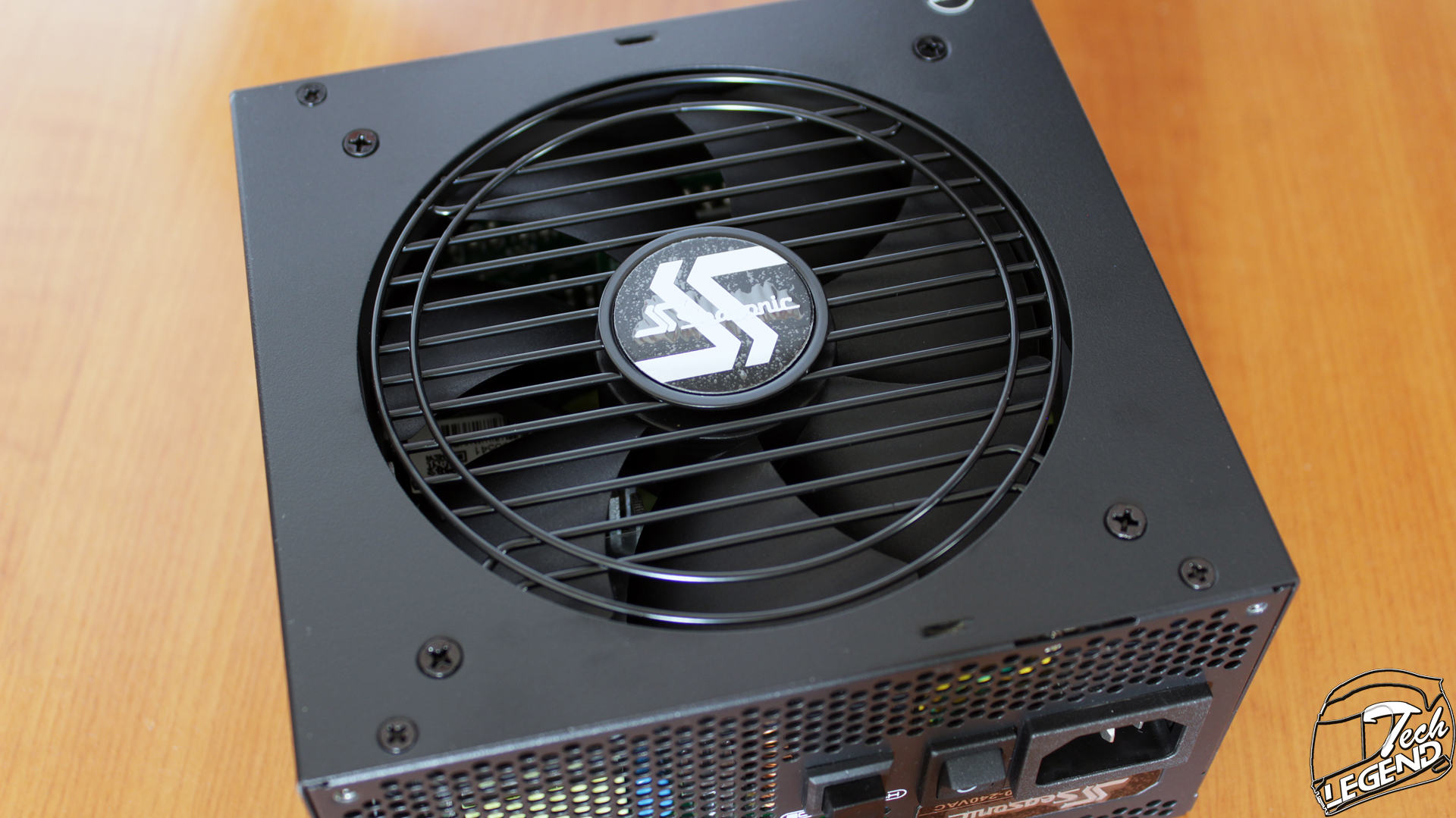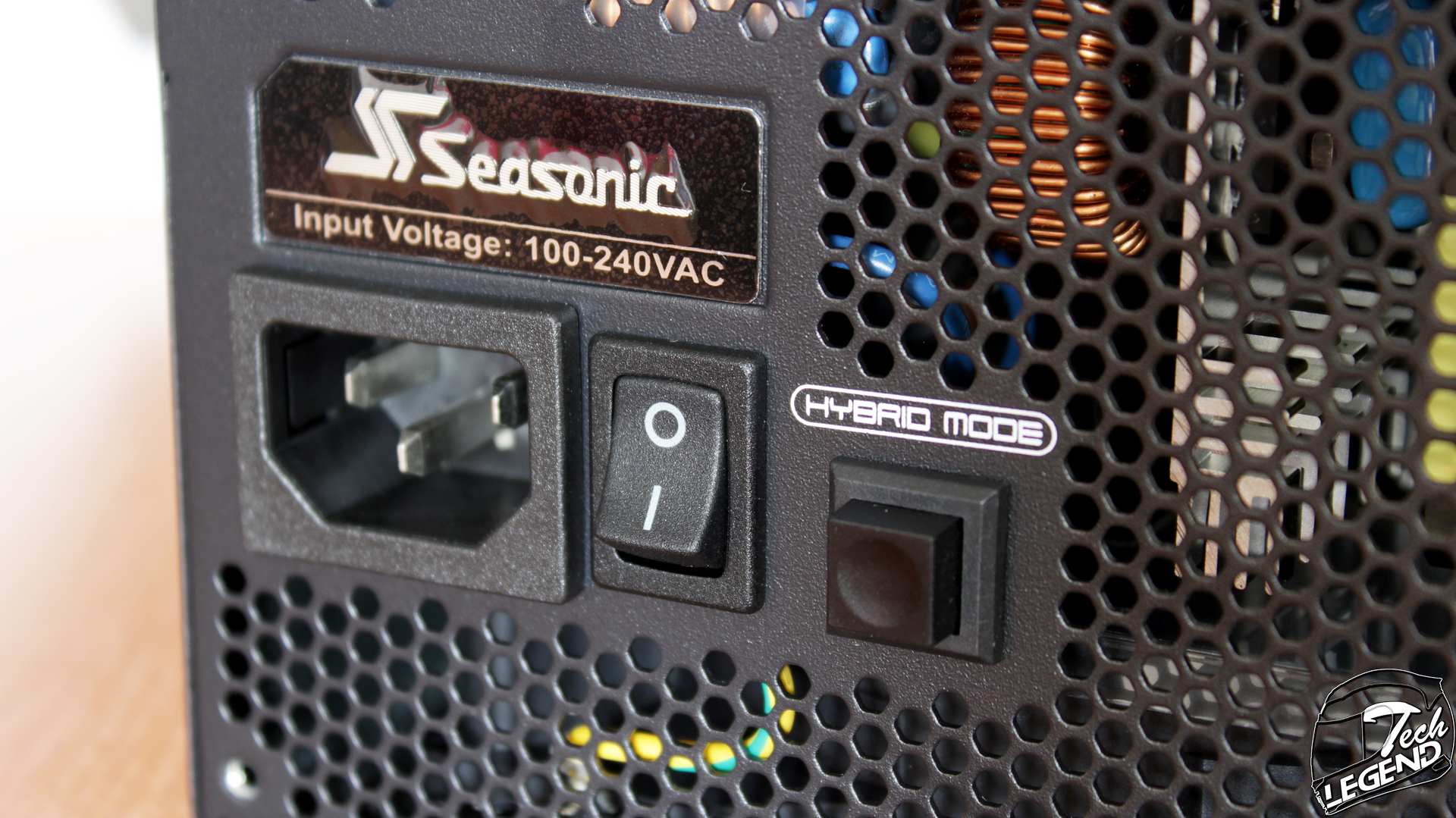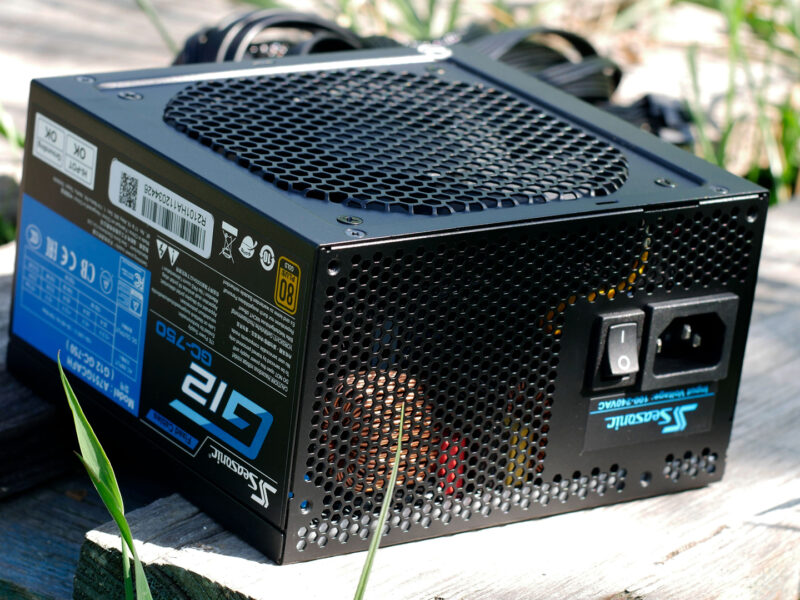Visual inspection
The FOCUS GX-750 has a simple design, nearly identical with that of the original Focus power supply models. The case of the power supply has a matte black finish, with no stickers placed on the front side. The power supply has a weight of 1.8kg, a width of 150mm, a height of 86mm with a length of 140mm.
The FOCUS GX-750 uses a single 120mm fan for the active cooling, which is controlled by the Seasonic Hybrid Silent fan control system.
The sides of the power supply are decorated with angular shapes stamped into the metal casing. On the upper and lower corners there are painted the Seasonic and Focus series emblems.
The back of the FOCUS GX-750 is simple in terms of layout, with a honeycomb pattern acting as the main exhaust vent of the power supply. On the left side, the AC slot and the On/Off switch are located. On the right, there is a button labeled “Hybrid mode” which will turn on or off the Seasonic Hybrid Silent fan control system.
At the front of the power supply there are the 10 slots for the modular cables. All these slots are labeled and marked to be easier to identify. The labels are not made from paper or plastic, Seasonic instead has decided to directly paint the writing and graphics on the metal surface of the power supply.
The top of the FOCUS GX-750 features the standard label which presents the main technical specifications of the power supply. This includes the serial number and a diagram of all the rails of the power supply, with the total wattage available.
The cables of the FOCUS GX-750 are completely black and flat ribbon style. These types of cables are easier to cable manage, thanks to their flat design. In addition, these can be stacked and tied together behind the motherboard tray for a better look. The only cable that is not flat is the 24Pin cable, which powers the motherboard. This cable is instead, covered by high quality sleeving.
The fan used with this power supply is manufactured by Hong Hua, and is the model HA1225H12F-Z with the specifications: 0.58A @ 12 VDC, 2200 RPM, 73.9CFM, 32.4db, 120 mm.
This fan has been used in numerous other power supplies from Seasonic and other manufacturers. The fan uses a Fluid Dynamic Bearing system, while the fan control is done by Seasonic’s three-phase Hybrid Silent system.
The fan is connected to the PCB with a 3-Pin connector, which makes it removable and easier to service.
The FOCUS GX-750 uses an improved Seasonic electronic platform, which shares many components and the general layout with other Focus series units. The passive cooling for the internal components is done by four solid metal heatsink which are attached to the important components of the power supply. The active cooling is done by the previously mentioned 120mm Hong Hua fan.
The filtering starts at the back of the power supply, behind the AC slot, with two X capacitors, four Y capacitors, and two coils. A small PCB is installed over the Y and X capacitors, and the coils installed on the underside.
The APFC section uses a single primary capacitor manufactured by Rubycon with the following specifications: 560uF 400V with a maximum operating temperature of 105°C.
The secondary PCB installed in front of the modular system has two smaller coils which are also paired with a couple of Nippon Chemi-con solid capacitors.
The PFC side of the power supply has a single Hongfa HF46F-G relay. On the right, some of the MOSFETs used by this unit are visible, these are manufactured by Infineon, and have the model number: 5R190CE. The MOSFETs make direct contact with the aluminum heatsink, and thus benefit from direct cooling.
The FOCUS GX-750 uses both Nichicon and Nippon Chemi-Con solid and standard capacitors. The only Rubycon made capacitor is the primary capacitor of the power supply.



























Hold-up time FOR Seasonic Focus GX-750 ??
Unfortunately, at the moment, I cannot measure Hold-up time.
Hello !! Could you please tell me how many decibels reach at full load (500 watt) and not the average of idle and loa together ?? Thanks in advance !!
The load noise was around 33Db, could not even hear it.
This is a late reply, I know, mainly due to the fact I was looking up reviews for a possible second hand deal. The main issue is noise, but unfortunately this review does not understand noise at all.
First of all, the standard for measuring noise is at 1 meter away from the source. A reading from any other distance cannot be compared with anything else and is completely meaningless. Doesn’t even help comparing the listed models, because who is insane enough to listen to their power supply with their ear 10 cm away from the fan????? They can have vastly differing readings from 10cm, yet be completely silent from a 1m or longer distance, because the sound pressure quickly weakens when spreading as a sphere in all directions. If the PC is on the floor and you sit next to it on a chair, can you hear it AT ALL? If not, (or your super silent case fans are louder), then it doesn’t matter AT ALL. Decibel measurements are misleading, because few people understand the logarithmic nature of sound levels and decibels. Also they need to be highly accurate, which brings us the next problem.
A margin of error of +/- 5 dB??? Really? What have you measured with? That is a total difference of 10dB, which represents a DOUBLING of the sound level!! Anybody who is not completely deaf will hear much smaller differences than that… In plain English: of two psus with the same measured dB, one could in reality have double the noise level due to measurement error margin? How useful info is that? “This car has 100 horse power, but it could also be 50 due to measurement error”. “What about that car with 70?”. “Oh, it could actually have 140 hp?”
Hi Brian,
Thank you very much for your comment and information. You are correct in your statement, and I am working towards building a better testing methodology for reviewing power supplies.
The 1 meter distance has been used to highlight the worst case scenario: having your PC right next to you on the desk and quiet fans which allow the PSU to be audible. Is it the best way to measure noise for a PSU? Absolutely not, but at the time of the development of this methodology it was the best of both worlds. As many complained that if I measure the noise too close to the PSU, it’s not realistic as they are not sitting close to the PSU.
I appreciate the constructive criticism and I can assure you that I am working towards acquiring better equipment and developing a better testing system for PSU reviews.
Many thanks once again and I wish you have a good day ahead!
Thanks for taking my comment constructively. Sorry if I was a bit harsh, unfortunately I’ve read too many reviews that ignore realistic issues while splitting hairs on some irrelevant numbers (irrelevant because they are all well within specs). Also too many sites/magazines that only push whatever crap they get advertising money for. I think independent reviewers such as you do an important job by putting out more honest information and educate and help people choose smartly. Which is why I think correctness and relevance are so important.
The problem with giving numbers that look like they are exact and objective, but are not, is that people get fooled. They want simple answers to complex questions. Thus 2-3 dB less in a chart “is definitively better” even if they notice that the margin of error is 3x higher… They just want to know “which is the best”. Well, it depends on the needs, so then they go for the safe choice, which are the reviews or what everyone else thinks (if it is the wrong choice, at least they can blame someone else).
When it comes to sound measurements, it is a dilemma. Either it needs to be done scientifically according to standards with highly accurate (=pretty expensive) equipment in an anechoic chamber, or from a purely practical point of view which is more realistic, but far less accurate. The first option allows comparisons with similar tests (done to the same standards), but does not really translate into practice. Option 2 gives more useful info, but can’t be compared to other tests and then everybody’s setup is different. No matter how good scenarios you come up with, you will never satisfy everybody… But this approach would still give a reasonable idea of reality with a reasonable effort, as long as some common sense is used and it is accepted that it can’t be perfect. Maybe ask your readers where and how they keep their equipment and use that to cover most typical scenarios? Add some reviewers impressions to cover what measurements don’t tell. Maybe use measurements to help order the PSUs from silent to loud and/or group the PSUs under descriptive classes (e.g. silent, barely audible, clearly noticeable, disturbing, f..ing loud). Just don’t mislead readers with highly inaccurate numbers presented as facts. Yes, some will still want hard numbers, but spare them of selfdeception. A simple dB measurement (even if accurate) does not even tell if the noise is high or low frequency. Our ears are very sensitive to high pitch noices such as motor clicking or coil whine and much less to low pitch sounds, such as air flow. And while there are adjusted spl scales to try to compensate that, they can’t compensate for “irritation” factor. Example: I have stopped noticing our quite noisy AC, but that barely audible clicking sound that recently started on my current PSU drives me nuts! It even cuts throgh my earphones and I can’t concentrate if I need to think. Which is why I ended up on this site, looking for info on a cheap second hand PSUs for that 8 year old spare work PC (its cheaper to by a complete similar PC than a new PSU…)
Having now found this site, I’m looking forward to interesting reviews.
P.S. That “f..ing loud” is descriptive of an AcBel that came with an ASUS office computer. It was like a feaf blower even when running idle
As I’ve said previously, I am trying to develop a better way to not only test these power supplies but to measure their noise output. I’m thinking of measuring the noise output in two different locations to get a good average. Mamny issues are still present, such as ambient noise and of course, things that are out of my control such as coil whine.
“Having now found this site, I’m looking forward to interesting reviews” – Thank you!